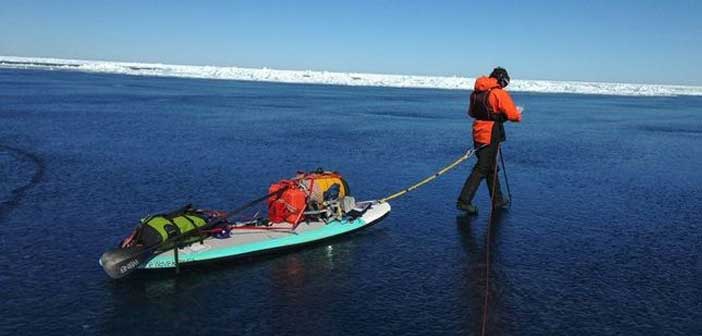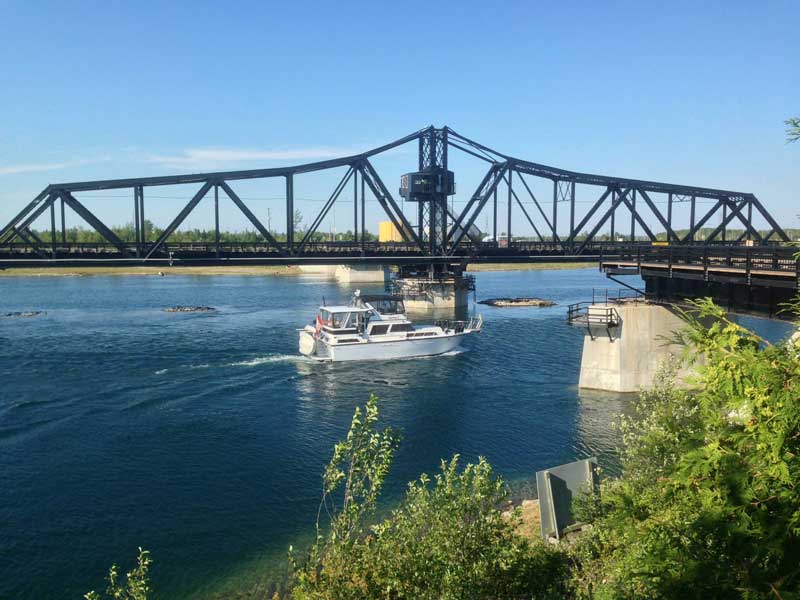MONTREAL—This past winter’s cold weather has resulted in higher than normal ice thickness, and coupled with those cold temperatures were heavy winds, resulting in another challenging year for the Canadian Coast Guard’s ice breaking efforts.
“I’m told that it’s a bit too early to confirm plans for assistance to the ferry,” noted Carol Launderville, spokesperson for the Canadian Coast Guard. “There may be a need for icebreaker assistance into the cement dock on the Whitefish River next week, again we can’t confirm plans that many days in advance.”
But the hardy men and women aboard Canada’s Great Lakes ice breakers are meeting those challenges.
“The Canadian Coast Guard’s icebreaking crews are working hard to open shipping lanes on the Great Lakes and St. Lawrence Seaway,” said Ms. Launderville. “A number of large winter storms in February, accompanied by strong winds and cold temperatures, have contributed to the rapid development of thick ice. Ice conditions are extremely challenging again this year. For example, in February severe ice in southern Lake Erie prevented access to some ports, forcing icebreakers and commercial vessels to change sail plans.”
The Owen Sound Transportation Company (OSTC) has already announced a four-day delay in the inaugural sailing of the MS Chi-Cheemaun ferry that connects South Baymouth to the Bruce Peninsula at Tobermory. Susan Schrempf, OSTC president and CEO, confirmed that the sailing schedule has been pushed back from the original May 1 to May 5.
“The Canadian Coast Guard works very closely with the United States Coast Guard to ensure that marine traffic can move safely through or around ice-covered waters,” noted Ms. Launderville. “Icebreaking services that benefit from this cooperation inlcude commercial vessels, fishing vessels, port operators and the general public.”
The coast guard spokesperson noted that shipowner groups and the two coast guards hold regular discussions on icebreaking.
She noted that the Canadian Coast Guard has two icebreakers working on Lake Ontario today, Monday, the CCGS Pierre Radisson and the CCGS Martha L. Black. “Both icebreakers are home-ported in Quebec City and are providing additional icebreaking capacity to the area,” she said. “Harbour breakouts at Bath and Picton are being conducted by the CCGS Martha L. Black. Another icebreaker, CCGS Amundsen, will be deployed from Quebec to the Great Lakes in the days to come. This is in addition to our two icebreakers that have been working tirelessly all winter on Ontario waterways, the CCGS Griffon and CCGS Samuel Risley. So far this year the Griffon and the Samuel Risley have completed about 180 escorts through the ice for commercial ships between Lake Erie and Lake Superior. CCGS Samuel Risley is a familiar sight around Manitoulin Island waterways and is currently working on Lake Superior.”
“While the Great Lakes ice coverage does not quite match last year’s peak of 92.5 percent, it is still widespread and thick in many places,” she said.
Environment Canada Ice Specialist Jacques Collin passed along a copy of the historical ice coverage for the week of March 24. “As you can see, while last year’s coverage at this time was higher than this year (78 percent versus 52 percent), it is still well above the median average of approximately 18 percent.
The current weather, then, isn’t providing much help in forcing the passages across the lakes this year.
“The difference between last year and this year was that last year at this time temperatures were warm and winds were calm, while this year we are still experience colder than normal temperatures that are forecast to remain cold,” said Ms. Launderville. “I don’t expect much ice decay for this next week.”
The ice cover helped inspire an adventurous duo to make the first-ever ice crossing of Georgian Bay on foot and by paddleboard. Scott Parent, of the Bruce Peninsula’s Fathom Paddle Guiding, and Zane Davies, of North Bruce based Explorer’s Tread (and a Lion’s Head firefighter with ice rescue experience), set out from Cape Croker First Nation (Neyashiinigmiing), located between Lions Head and Tobermory, on March 11 and headed east, pulling a modified sled loaded up with ice climbing gear, pick axes, camping equipment and dry suits complete with neoprene booties and moccasins.
This wasn’t Mr. Parent’s first ice crossing adventure; he traversed the Sweetwater Sea solo in 2011. After meeting Mr. Davies at the Outdoor Adventure Show the like-minded duo began to make plans to cross Georgian Bay. Although the heavy ice cover might seem to have been solid across the entire bay, truth is there are always open channels and patches of open water to cross, so the pair had to ensure they had modified equipment that would allow them to cross those open patches and still stand up to the steady wear and tear of ice on the sled bottoms.
After a comfortable night’s sleep after the first day on the ice, the pair awoke to find a channel had opened up that had not been there the night before, highlighting the many things that could easily have gone wrong.
After three days on the ice, on March 13, the daring duo arrived in 12 Mile Bay, having travelled making them likely the first people to ever walk across the belly of Georgian Bay.
“We know the Anishinabek and Wyandot people have stories of crossings on the Bay, to Christian Island and crossing the Fathom Straight to Manitoulin,” said Mr. Parent. “But there are no practical reasons to tackle the belly of the Bay like we did. It is possible we are the first to pull this off. But it was more of a salute to the peoples of the Bay that used the ice to travel on, historically. It had nothing to do with trying to be the first. My family used to live as full-timers on Georgian Bay. Winter was when neighbouring places became accessible by traveling on the ice.”
The duo spent their third day hauling their equipment between the Western’s and 12-mile Bay, ending their crossing at Moose Deer Point First Nation near Mactier, having marching and paddled an impressive 82 kilometres in an epic journey.




